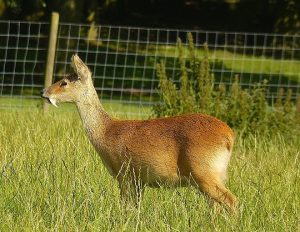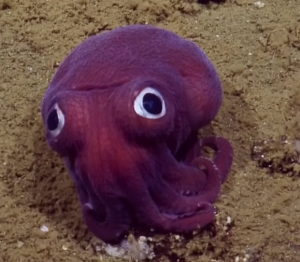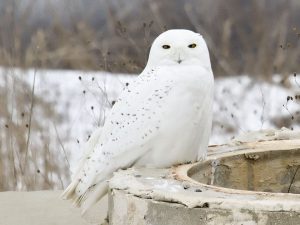Podcast: Play in new window | Download (Duration: 10:55 — 12.1MB)
Thanks to Richard of NC, Richard my brother, Siya, Ezra, and Owen and Aksel for their suggestions this week!
Further reading:
Creature Feature: Googly-Eyed Stubby Squid
Nocturnal Spiders Use Trapped Fireflies as Glowing Bait to Attract Additional Prey
A male vampire deer:

The adorable googly eyed squid [still taken from video linked above]:

The snowy owl [photo by Bill Bouton from San Luis Obispo, CA, USA – Snowy Owl, Bubo scandiacus, male, CC BY-SA 2.0, https://commons.wikimedia.org/w/index.php?curid=19899431]:

Show transcript:
Welcome to Strange Animals Podcast. I’m your host, Kate Shaw.
This week for monster month, let’s learn about some animals that are considered spooky, although in actuality they’re just regular animals who don’t even know the meaning of spooky. Thanks to Ezra, Owen and Aksel, Richard from NC, my brother Richard, and Siya for their suggestions!
We’ll start with the two Richards. Richard from NC suggested vampire deer, and my brother Richard suggested zombie salmon.
The vampire deer is more commonly called the water deer, but considering it has tusks growing down from its upper jaw that look like fangs, vampire deer is an excellent name. Females have short tusks, but in males they grow quite long, sometimes over 3 inches long, or 8 cm. Since the animal only stands about two feet tall at the shoulder, or 65 cm, that’s pretty impressive. Its hind legs are longer than its front, so that when it runs it sort of bounces like a rabbit. It has a very short tail, small rounded ears, and is golden brown in color with a lighter underside. It doesn’t have antlers. We talked about the musk deer in episode 366, which also has fangs instead of antlers, but the vampire deer isn’t closely related to the musk deer.
The vampire deer currently lives in Korea, China, and Russia although it used to be much more widespread. It mostly lives in reedy habitats near rivers, and it’s a solitary animal although females will sometimes congregate to eat. Males protect their territories by fighting with their tusks, although they don’t actually drink blood.
As for the zombie salmon, it’s not a type of fish but something that can happen to an ordinary salmon. The salmon is a fish that famously spends most of its adult life in the ocean, but travels up rivers to spawn. The eggs hatch in freshwater and the baby fish grow up in the river, and then they migrate to the ocean and live there for almost the rest of their lives. Eventually the fish is fully mature and ready to spawn, so it travels to the river where it was hatched, fights its way upstream, and the cycle starts all over with the new generation.
Almost all salmon die after spawning. This is partly because the energy requirements of swimming upstream is so high, but also because a salmon is genetically programmed to die after spawning. This is called senescence, and while it’s common in invertebrates like octopuses and some insects, it’s rare in vertebrates. Not only that, there’s not enough food for an adult salmon in the spawning area, and an adult salmon’s body is adapted for salt water, not fresh water, so it can’t live long in rivers as an adult anyway.
A small number of female Atlantic salmon are able to return to the ocean, recover and regain their strength, and spawn again a few years later, but for all other species, after spawning, that’s it. Within days all the salmon have died.
But sometimes, rarely, a salmon remains alive for weeks after spawning. It doesn’t have the energy to return to the ocean, and its body is in the process of shutting down for planned senescence, and the freshwater is causing damage to the fish’s skin. But still it survives, growing more and more raggedy, just like a zombie in a movie. But unlike movie zombies, it doesn’t want to eat brains. Eventually the zombie salmon dies, if something doesn’t catch and eat it first.
Next, Siya suggested the googly-eyed squid. Some people find squid and octopuses scary because they look so strange, but I admit I added this squid to the episode because I think its name is funny. It’s also called the stubby squid or the googly-eyed stubby squid. Its scientific name is Rossia pacifica, which gives you a hint that it lives in the northern Pacific Ocean. In the winter it likes shallow water without strong currents, but in summer it migrates to deeper water where it doesn’t get too warm.
The googly-eyed squid is small and closely related to the cuttlefish. It grows less than four and a half inches long, or 11 cm, including its eight short arms and two retractable tentacles. It’s usually reddish-brown or purplish in color, but like most squid it can change color when it needs to. It gets its name because it has large eyes that show white around the edges and have a black pupil, which makes it look like it has googly eyes.
During the day, the googly-eyed squid buries itself most of the way in sand or mud at the bottom of the sea floor, with just its googly eyes showing so it can watch for danger. At night it comes out to hunt small animals like crabs and other crustaceans, mollusks, and fish, but what it really likes is shrimp. Naturally, it has good eyesight.
Next, let’s talk about a bird that some people find spooky. Ezra, Owen, and Aksel all suggested the snowy owl.
The snowy owl is mostly snow-white although young birds have black and gray markings. Its eyes are yellow and it often hunts in the daytime, but not always. Its wingspan can be as much as six feet across, or 1.8 meters.
The snowy owl lives throughout the Arctic and nearby regions, especially in summer, but sometimes travels long distances to find food. It’s also migratory, traveling south for the winter. Snowy owls have been spotted in such far-flung places as Hawaii, Bermuda, Pakistan and India, Iran, and Japan and Korea.
The snowy owl mostly eats small animals like lemmings and mice, although it will kill and eat pretty much anything it can catch, including ducks and other water birds, fish, and even insects and frogs. It will sometimes eat carrion and even sometimes steals food from other birds. It swallows small animals whole, and a day or two later, regurgitates a compacted pellet made up of the indigestible parts, including bones and fur. A lot of predatory birds do this, not just snowy owls. Scientists who study the birds love finding these pellets, because they can dissect them and learn what the bird has been eating.
Not only does the snowy owl make its nest on the ground, sometimes it hunts on the ground too, just running along after an animal on its big feet.
This is what the snowy owl sounds like:
[owl call]
Let’s finish with an invertebrate that a lot of people are scared of, a spider! This particular spider is a species of sheet-web spider, which lives in Taiwan. It’s a nocturnal spider that was only described in 2012. Unlike a lot of spiders, which build upright webs to trap insects that are flying along between branches and twigs, the sheet-web spider builds its web horizontally just above the ground.
The webs are light-colored and reflect light. The spiders build their webs in shady areas, and scientists think that moths see the light reflecting off the webs, and think the webs are actually the ground in an area open to the sky. Moths like open areas like this, and moths also happen to be one of the spider’s favorite foods. When a group of scientists experimented by darkening some webs with charcoal dust, they determined that the darkened webs attracted considerably fewer moths.
But it turns out that the sheet-web spider does something even more extraordinary. If a firefly gets caught in the web, the spider doesn’t eat it—or at least, not right away. It lets it stay in the web, flashing its light. Scientists noticed this and were intrigued. Did the fireflies not taste good, or was something else going on?
They placed LEDs that blinked like fireflies in some webs, but not in others, and monitored the results. It turns out that three times the number of insects were attracted to the webs with fake fireflies, and most of those were other fireflies. Fireflies attract a mate by flashing. The spiders were taking advantage of having a built-in lure stuck in their webs. So even though spiders are very tiny and have tiny brains, sometimes they’re pretty darn smart.
You can find Strange Animals Podcast at strangeanimalspodcast.blubrry.net. That’s blueberry without any E’s. If you have questions, comments, or suggestions for future episodes, email us at strangeanimalspodcast@gmail.com. We also have a Patreon at patreon.com/strangeanimalspodcast if you’d like to support us for as little as one dollar a month and get monthly bonus episodes.
Thanks for listening!